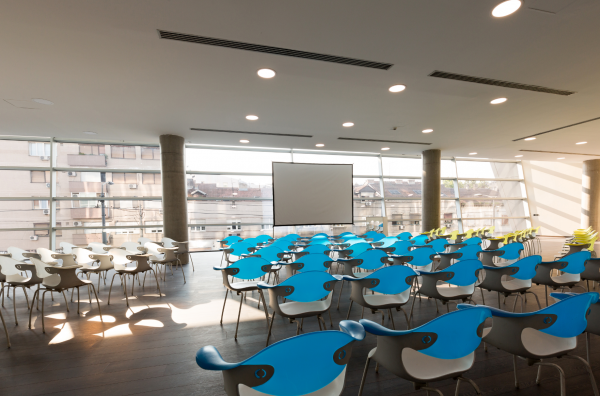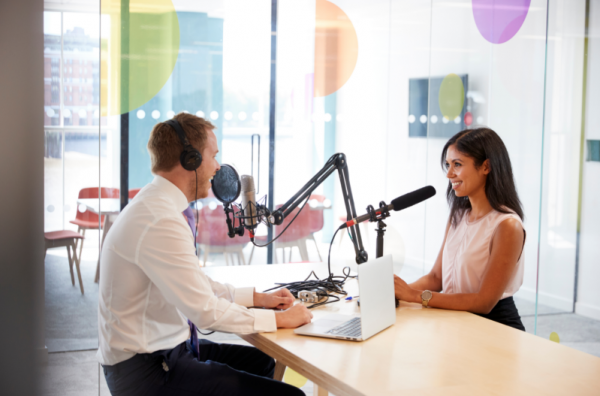One Foot in Two Worlds—Expert Advice on Hybrid Events, Podcasts, and AV Tech

Laird Crawford has straddled the virtual and in-person worlds for some time now. He edits the mumbles out of podcasts and makes people look better on video than they do in person. Over the last 25 years, Laird’s company, Ian Ryan Interactive, has been my go-to for audio-visual success. You can probably guess that in 2020 they were superheroes for .orgSource and their other clients.
Ian Ryan has been in the business of putting professional polish on all sorts of productions from annual meetings to eLearning since 1993. They serve associations and companies in the Chicago metropolitan area as well as in Washington, DC and New York City. And they even produce a local NBC TV show.
I invited Laird to share our experiences with him this year with the Association 4.0 Podcast audience. He had plenty of savvy advice for both newbies and more experienced virtual meeting planners. This article recaps the episode.
.orgCommunity, our professional development partner, produces two annual conferences. Networking is a major component of both. That our September 2020 event, Solutions Day, would be virtual was a foregone conclusion.
I’m comfortable with all things digital. So, I thought the logistics for Solutions Day would be a piece of cake. In fact, the experience was more like working a Rubik’s cube. I spent some late nights twisting things back and forth trying for perfection. In the end, I was pleased but humbled.
In May 2021, when it was time to start planning for the Innovation Summit, we were eager to return to face-to-face interaction. The vaccine and the pandemic gave us a window of opportunity, and we jumped, making the decision to mix and match what we learned about virtual production with a live meeting.
We also wanted to test the water on a blended event and report our experiences back to our community. It was a high dive, but with Laird’s guidance I knew there would be a successful landing.
Be a Creative Problem-Solver
The event site was the American Society of Gastrointestinal Endoscopy’s conference facilities in Downers Grove, Illinois. This was the setup:
- Up to 60 in person participants.
- An unspecified number of online attendees
- The keynote and three other speakers to be broadcast live
- Four presentations to be recorded on Zoom
- A co-creative session and speaker Q&As to be broadcast live

Last but definitely not least, anyone who wanted to rock their home office to our 80s tribute band, would be more than welcome to join the fun at the reception.
“We started by inspecting the ASGE site to identify the requirements,” Laird recalls. “The goal was to determine the placement of the cables and cameras and assess how much equipment would be needed. Separate rooms for the presentations and the Q&A sessions was a unique challenge. We strung cable and brought cameras and staff to manage both the recording and live stream.
“You have to put on different hats, problem-solve, and go from there,” Laird notes. “ASGE’s onsite crew were wonderful. We collaborated and supplemented our equipment with what they had on hand.”
Pay Attention to the Details
Laird’s point is important. People frequently ask me to recommend a platform. But technology isn’t what makes or breaks your meeting. AV support from creative people who understand how to maximize the experience of both the online and in-person audience is the critical component.
“You have to be able to shift gears,” Laird advises. “I wanted to be sure that the attendees didn’t need to login a second time when they switched from the morning sessions to Q&A in the other room. We had to have a seamless transition between locations for both the online and in-person audience.”
Giving the virtual attendees a presence helps everyone to feel connected. During the Q&A Laird was able to focus on the person asking the question, whether they were online or in the room. Details like that made the event feel truly blended.
Listen Up

I’m not sure whether Zoom fatigue is responsible for the passion for podcasts. Since the pandemic, many of my colleagues have traded their favorite views for the audio version. In a culture that’s obsessed with multitasking, podcasts offer an easy way for members to connect with your brand.
Laird’s been producing podcasts since before they had a name. I wanted to know how their new-found popularity coupled with the pandemic has changed his process.
“Annual meetings used to be the most popular venue for recording for obvious reasons,” Laird advises. “We still use that opportunity. We might record 40 to 50 podcasts over four days, leaving the client with content they can release throughout the next year.
“But we have many other ways to produce episodes. One easy option is to send our customer a two-channel recorder with microphones. Speakers can record the discussion and return it to us to edit. We remove the distractions and ambient noise and adjust the audio levels. Clients also come to our studio, or we travel to their location.
“In addition to capturing, editing, and polishing content, we also handle the backend technology. We’ll add metadata, branding, and distribute the episodes across all the popular channels.”
Consider the Audience
Podcasts, Laird was quick to emphasize, are like any other communication’s medium. To be successful you want to first consider audience preferences. All the other decisions flow from there.
“Think about the best format to reach your preferred listeners. For example, medical associations that provide fee-based continuing education may want to publish the episodes through their learning management system. Where information is intended for wider distribution or to the public, you might make it available on a variety of platforms.
“Align your approach to the presentation. There’s a difference in dynamic between two experts talking and a panel with six or seven participants. Think of the episodes as a radio show and consider how you as a listener would like to engage.
Repurpose Leftovers
.orgSource takes a waste not want not attitude to content. We try to never throw away our leftovers. Wherever possible, we repurpose. I was curious to hear how Laird’s other customers are maximizing their communications.
“Any piece of content can have multiple uses,” Laird advises. “An educational video can be edited and used to promote an upcoming event or for general marketing. Sometimes when you have several experts together discussing specialized information, it’s easy and inexpensive to do additional podcasts that are directed toward a broader audience. You can also use the opportunity to create a practice management tutorial or “how to” videos for your members. So, what would have been one piece of content, with a little additional effort can become four.”
We tend to think of digital activities as innately efficient. But the human capacity to reinvent and repurpose maximizes that power. So, when you have one foot in the digital world, remember for peak performance to keep the other on firmer ground.
Contact Laird at: laird@ianryan.com
